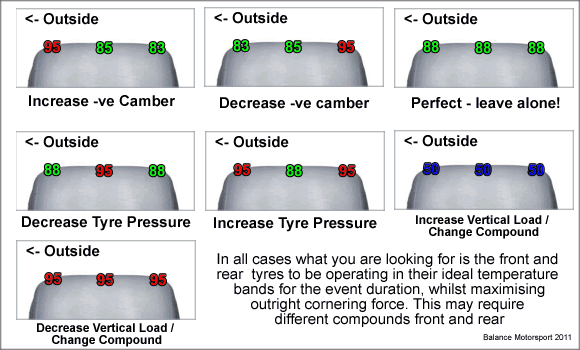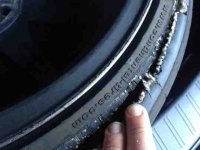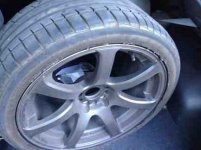You are using an out of date browser. It may not display this or other websites correctly.
You should upgrade or use an alternative browser.
You should upgrade or use an alternative browser.
Wheel and tire tech
- Thread starter Spamby
- Start date
Spamby
Meat Product Toy
Idk if you've ever seen the process of building tires from scratch or not, but it looks like the point where the bead is bonded to the sidewall is where it tore. Crazy. Was that tire a little low on pressure?
Probably low. Felt a little squirmy in the rear right before she popped.
Spamby
Meat Product Toy
Holy f**k!!! Hope everything is still running fine after those angry noises!
We'll see but I'm sure it will
Robert Viehweger
Daily Driver
Someone was just asking me tire questions. Actually, a few people the last few days. Sent them to this post because it's awesome information. I haven't been into wheels and tires for mine, so I haven't looked at it, but now I'm glad I did!
Don't forget, tirerack.com has a lot of great information.
Very, very informative thread. I do have something to add though, and I might be right, I might be wrong. When "on a lowered car" is mentioned, maybe elaborate a bit more on the size of drop.
What I mean, I just got my Rota's yesterday, they are +25. Now, if I was RCE yellows, no way without a fender roll. However, I went with the mild drop of the eibach pro kit springs, I have about 2" of clearance with a medium stretch, Its not extremely aggressive, but, it is noticeable. Now, I know if I hit a dip going way to fast, I might rub, but, I doubt it (forgot about the wheels and tires on the way to work this morning, No scratch on a 8ish inch deep, 2 1/2-3ft dip).
That said, it is up to you as the end user to determine if your spring rate, drop height, et, tire size and if stretched or not will allow a safe amount of clearance.
One more example, the gentleman I purchased the wheels from was on BC coilovers, the stretch, and a fender pull, with no camber, you can see where the tire hit at a bit.
Sorry to add more to the huuuuuuge write up you made, but, figured I would throw out my experience with a low et wheel.
What I mean, I just got my Rota's yesterday, they are +25. Now, if I was RCE yellows, no way without a fender roll. However, I went with the mild drop of the eibach pro kit springs, I have about 2" of clearance with a medium stretch, Its not extremely aggressive, but, it is noticeable. Now, I know if I hit a dip going way to fast, I might rub, but, I doubt it (forgot about the wheels and tires on the way to work this morning, No scratch on a 8ish inch deep, 2 1/2-3ft dip).
That said, it is up to you as the end user to determine if your spring rate, drop height, et, tire size and if stretched or not will allow a safe amount of clearance.
One more example, the gentleman I purchased the wheels from was on BC coilovers, the stretch, and a fender pull, with no camber, you can see where the tire hit at a bit.
Sorry to add more to the huuuuuuge write up you made, but, figured I would throw out my experience with a low et wheel.
Spamby
Meat Product Toy
Good experience. I never would have guessed you could get away with that but nevertheless.
Stock GR suspension, +38 wheel, 18x9.5 with a proper 265/35 tire would rub on occasion during hard dips or especially at speed.
Drop it 1.5 or so inches and it's a no go.
My experience.
Might I ask what sized wheels and tires your running?
Stock GR suspension, +38 wheel, 18x9.5 with a proper 265/35 tire would rub on occasion during hard dips or especially at speed.
Drop it 1.5 or so inches and it's a no go.
My experience.
Might I ask what sized wheels and tires your running?
Spamby
Meat Product Toy
Oh and to try and combine every different wheel and tire size with the many offsets, and different year cars, it would be truly mind blowing to try and come to a definite conclusion as to what works and doesn't. Add that with spring rates and all of the others you mentioned, oh boy my brain hurts lol.
Lol. I knew it would be a bit much, that's why I threw in the "you as an end user" Haha! I am 17x9.5 et25. Now, the spring rate of the eibachs is a major contributing factor, they are quite a bit stiffer than the stickers. But yes, the combinations are endless. But, even if I Jack up the front corner to "flex", it still has clearance, so, there is the swaybar showing its capabilities. But, I'd love to stay and further this, I'll be back tomorrow, have to work at 4, or should I say, go to the place I work and sleep? Lmao!


Alin
Diehard Car Enthusiast!
http://www.1010tires.com/About/Tech
http://t3hclap.com/brembo-clearance
here are some more resources if you want to add.
teh clap is on iwsti. hes a wheel and suspension guru. take a look when you get a chance
http://t3hclap.com/brembo-clearance
here are some more resources if you want to add.
teh clap is on iwsti. hes a wheel and suspension guru. take a look when you get a chance
Spamby
Meat Product Toy
Here is a good calculator for finding out where your wheel/tire will be when changing offsets and tire sizes. The illustration is a bit rudimentary but it illustrates what's needed.
After adding your criteria, you can go to your car and put a tape measure on the wheel edge to find out where it will sit in relation to the fender or whatever you want to measure.
http://www.willtheyfit.com/index.ph...ameter2=18&wheelwidth2=9.5&offset2=38#content
After adding your criteria, you can go to your car and put a tape measure on the wheel edge to find out where it will sit in relation to the fender or whatever you want to measure.
http://www.willtheyfit.com/index.ph...ameter2=18&wheelwidth2=9.5&offset2=38#content
Hey everyone, I decided to bump this great thread for viewing by our newer members, since we last discussed this almost 5 years ago.
Hopefully it'll answer a lot of questions for everyone. :subaru:
Hopefully it'll answer a lot of questions for everyone. :subaru:
5 psi increments starting from flat to max pressure.
I'll do it this weekend when I change the oil in the car.
This will be only for my tire setup but should give a good roundabout.
Without reading until the very end I post this to ponder, tire pressure is way more critical than one may think. Pressure, over or under can effect how the rubber heats. This is called heat cycle. In order for a tire to gain maximum grip is must reach a temperature on which the sticky stuff is cooking off the tire. Tire pressure increases as the tire's carcass heats. Too much cold temperature pressure prevents the tire from heating to the proper sticky temp. Too little overheats the tire and it gets really greasy. On track days most tire manufacturers will give you a ballpark stab at what your temps should be. You can compare that pressure to the pressure of the tire after some hot laps. In a previous life I raced a Ducati with WERA. On a motorcycle that hot/cold difference was around 3%. The principal us the same for a car, however the difference, well I have no clue. But I suppose the point being 1 or 2 pounds makes a difference on the street or on the track.
Grinder34
Track Monkey
Without reading until the very end I post this to ponder, tire pressure is way more critical than one may think. Pressure, over or under can effect how the rubber heats. This is called heat cycle. In order for a tire to gain maximum grip is must reach a temperature on which the sticky stuff is cooking off the tire. Tire pressure increases as the tire's carcass heats. Too much cold temperature pressure prevents the tire from heating to the proper sticky temp. Too little overheats the tire and it gets really greasy. On track days most tire manufacturers will give you a ballpark stab at what your temps should be. You can compare that pressure to the pressure of the tire after some hot laps. In a previous life I raced a Ducati with WERA. On a motorcycle that hot/cold difference was around 3%. The principal us the same for a car, however the difference, well I have no clue. But I suppose the point being 1 or 2 pounds makes a difference on the street or on the track.
Yeah it makes a big difference.
I'm not sure if it's in the previous few pages, so here goes my writeup:
Let's ignore some effects of camber, dynamic loads, etc... and simplify things for the moment.
The surface of a car tire is flat. It lies flat against the road. The sidewalls provide some stiffness, but what's really holding the car up is the air....if your tires deflate, your rims run right against the ground (again, ignoring runflats). Ok, so with the tires under-inflated, the sidewall is pressed into the ground harder than the middle of the tire (no sidewall). Meaning that your tire actually bends inward slightly, as if it was cupping the road. This gives you more grip at the outside of the tires than the middle As you increase inflation, that cupping decreases, until you're at the ideal tire temp where everything is perfectly flat. Ta-da, max grip everywhere! But as you go too far, the air is pushing down too much, and the sidewalls can't keep up. So it does the opposite of the cupping, and actually balloons/bulges outward. Now you're gripping the road mainly with the middle of the tire and not using the edges to the fullest extent!

To tell if you have the correct pressures, you can use a tire thermometer (pyrometer) to measure. Yep, temperature will tell you about your inflation!
First, ignore that infrared thermometer. Unless you're doing something crazy like leaning out a window, reaching under the car, and aiming it at the tire mid-track...it's gonna give you a bogus number. By the time you slow the car, pull to a safe area, get out, walk to each tire, etc... everything will be meaningless. What you want is a probe pyrometer, that you actually jam into the tread.
Ok, so you've got your equipment, you've done some hot-laps...how do you know if your tires are inflated right? Measure each tire's near the outer sidewall, right in the middle, then near the inner sidewall.
1) If the two outer ones are HOTTER than the middle one - underinflated (the middle part of the tire isn't creating grip...friction...heat)
2) If the two outer ones are COOLER than the middle one - over inflated
3) If they're all the same - goldilocks, baby.
Ok, so there are some other options, too, but I said we were ignoring camber. Lets throw it back in.
(we ignore the middle reading for this part)
4) The inner temp is HOTTER than the outer - too much negative camber
5) The inner temp is COOLER than the outer - too much positive camber
6) they're both the same - Now we're cooking!
To be fair, you should probably get your camber dialed in first (if you have the ability). But you can combine 1/2/3 with 4/5/6, such as
7) If your temperature increases evenly from inside to outside, your pressures are probably ok, but you have too much camber.
8) If the inside and middle temps are both hotter than the outside - you probably have too much camber and too much pressure
9) etc...

Last edited:
Similar threads
- Replies
- 0
- Views
- 1K


